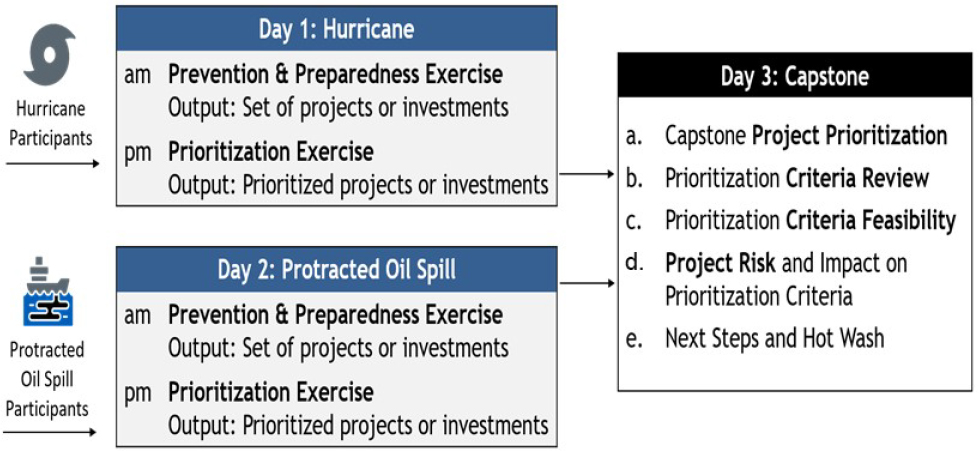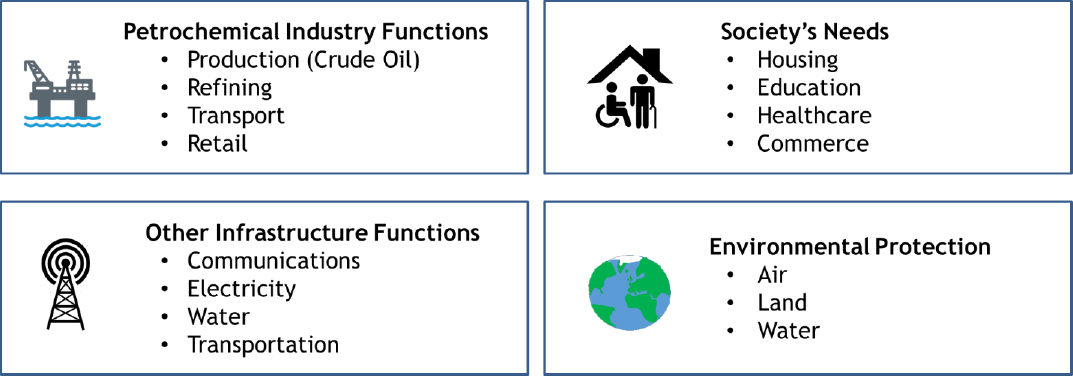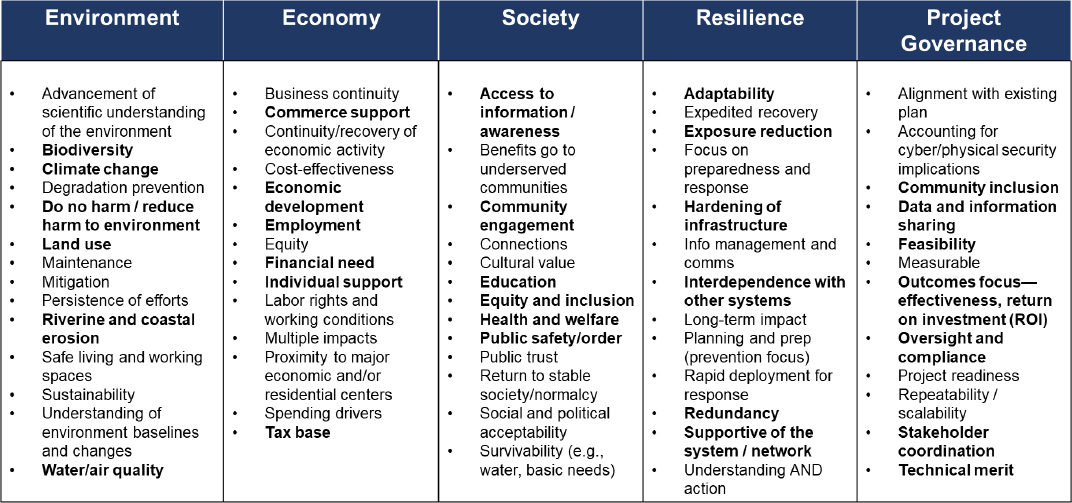Summary
To help prioritize among possible investments to improve the resilience of built infrastructure in the Gulf of Mexico region,1 the National Academies of Sciences, Engineering, and Medicine convened a diverse group of experts for a 3-day interactive workshop on November 15, 16, and 18, 2021. This workshop was held as communities surrounding the Gulf continue to experience frequent, destructive disasters, some infrastructure in the region continues to degrade or fail from exceeded capacity and delayed maintenance and replacement, and climate change threatens previously unimagined impacts. On the same day that the workshop began, President Biden signed the bipartisan Infrastructure Investment and Jobs Act (IIJA, P.L. 117–58), which will offer opportunities to meet identified needs with additional funds. But even with the IIJA, the funds are limited, so the region and the nation need ways to prioritize investments informed by sound science and engineering.
The workshop, titled Investing in Resilient Infrastructure in the Gulf of Mexico, demonstrated and refined a process to help inform recommendations for prioritizing infrastructure investments across sectors and anchored in the Gulf region energy industry. The workshop had four main objectives:
- Use two scenarios—a hurricane and a protracted oil spill—to start discussions on infrastructure vulnerabilities
- Identify and prioritize projects or investments to reduce those vulnerabilities, thereby strengthening infrastructure resilience in the Gulf region
- Identify criteria that would drive infrastructure investment decisions and prioritization
- Define criteria that will form the foundation of a repeatable prioritization framework for infrastructure investment decisions through cross-comparison of insights from each of the two scenarios
The workshop also introduced three policy questions to guide discussion:
- What choices would maximize resilience return on federal investments in infrastructure and promote equity, fairness, economic effectiveness, and other goals and requirements?
- How can we overcome obstacles to making the best investments in infrastructure?
- How can we mitigate against private infrastructure assets becoming public liabilities?
As a demonstration activity, this workshop does not provide a definitive or authoritative prioritized list of projects, nor does it provide a consensus of the workshop participants. Rather, the workshop provides a first step in a process bringing together those with responsibilities and
___________________
1 There are many different definitions of infrastructure in use today. This workshop focused on the built environment, including human-fabricated physical structures and interventions in the natural environment. Social infrastructure is supported by these investments, and although it may require its own major investment, that was outside of the scope of the workshop.
stakes in prioritization across sectors, jurisdictions, and interests. This summary provides insights gained from the process and innovative ideas that arose in discussions.
WORKSHOP OVERVIEW
Approximately 50 infrastructure, oil and gas, petrochemical, emergency management, and Gulf region experts from federal, state, and local governments, industry, non-governmental organizations, and academia participated in this 3-day workshop. Half of the participants joined Day 1 on November 15 for a set of in-person exercises focused on a hurricane scenario; half of the participants joined Day 2 on November 16 for a set of in-person exercises focused on a protracted oil spill scenario. The groups were split to ensure that they were small enough for every attendee to participate substantively and that appropriate expertise was represented in each group. Exercise materials included detailed scenario descriptions and chains of adverse events likely prompted by each scenario. Participants reviewed and updated that information, discussed vulnerabilities related to each scenario that impact local infrastructure, and then brainstormed and prioritized projects to address those vulnerabilities. As used here, “project” refers to any concrete action that can be taken to prevent or mitigate any of the adverse events prompted by the scenarios. All participants joined Day 3 virtually on November 18 for a set of capstone exercises that compared and built upon ideas discussed in Days 1 and 2. (See Figure S-1 for an overview of the workshop.)

Discussion and information collection were structured around four domains (see Figure S-2): (1) oil, gas, and petrochemical industry functions; (2) other infrastructure functions; (3) society’s needs; and (4) environmental protection. These domains provided a useful mechanism to organize inputs and feedback. On Days 1 and 2, participants joined small groups designed to include experts with diverse backgrounds, and all participants rotated through all domains. On Day 3, participants joined small groups designed to include experts with similar backgrounds, and they spent their time in a domain that closely aligned with that background.

The National Academies also arranged for three keynote speakers to set the context for this event. Jason Tama, White House National Security Council Director for Resilience and Response, emphasized what an opportune time it was for this workshop in light of the signing of the bipartisan Infrastructure Investment and Jobs Act into law. He hoped conference participants would identify key principles to prioritize investment in infrastructure resilience and then share those principles with decision makers. Lt. General Thomas P. Bostick, retired Commander of the U.S. Army Corps of Engineers, pushed for broad, systems-level thinking to inform infrastructure investment. He stressed the importance of developing ideas that are measurable and actionable, and he mentioned stakeholder involvement and engagement in infrastructure investments as absolutely imperative. Finally, Marcia McNutt, President of the National Academy of Sciences (NAS), spoke about setting priorities on upgrading infrastructure, striving for equity in outcomes, and harmonizing stakeholder interests and values. She advocated for forward-thinking investments that consider future changes such as climate change.
WORKSHOP TAKEAWAYS
The Investing in Resilient Infrastructure in the Gulf of Mexico Workshop demonstrated and advanced a process and framework that federal agencies and their partners in other jurisdictions might employ to identify and prioritize investments that would increase infrastructure resilience. Expert participants from the public sector, private sector, and academia emphasized the necessity of community engagement, of working to overcome long-standing obstacles, and of moving into the future, if infrastructure resilience is to be achieved. Key workshop-wide takeaways fell into these three broad categories and are outlined in Box S-1 and described after the box. They are expanded upon throughout the body of this proceedings. Workshop participants also identified criteria that form the basis of a prioritization framework for selecting high-value projects that would likely increase infrastructure resilience in the Gulf of Mexico. Finally, participants identified 306 individual project ideas; projects identified as high priority are included in the body of this proceedings, and a comprehensive list is located in Appendix B.
The following descriptions elaborate upon the key takeaways outlined in Box S-1, highlighting points made by some participants across all 3 days of the workshop. Note that these do not necessarily reflect a consensus of the participants’ perspectives.
Necessity of Community Engagement
Emphasizing Local Leadership
Participants said that local leadership is essential for projects to be effective, ensuring that local needs are understood, communicated, and considered; buy-in of new projects is achieved; and project outcomes benefit all relevant stakeholders. This includes increasing local leadership in disaster response decision-making, which is critical to increasing resilience. Many of these decisions are too often made at the state or federal levels, insufficiently including local responders.
Promoting Community Involvement
Decision makers and project leads are more likely to achieve stakeholder buy-in if they engage a community early and often.2 Such engagement includes getting input from lower-income and impoverished communities on project approaches, partnerships between project managers and the community, and involving local leadership in project-related planning and execution. Community engagement helps to ensure that community members understand the benefits that new projects or changes can offer. Community engagement should not be thought of as a one-time event, a final output, or a stage, but as an ongoing process that is vital to building and maintaining trust.
___________________
2 Community engagement pertains to local government as well as the residents, businesses, and organizations in that locality.
Improving Communications and Transparency
Effective communications between government program managers and the community would be ongoing, frequent, and clear. Such communications would include more educational information about projects and their benefits, and also information about local threats and hazards, what kinds of impacts the community should expect, how to prepare for those impacts, and how to get support. Participants said that the media must be a partner. A strengthened relationship between the media and all levels of government, and enhanced information sharing between them during a protracted disaster response, especially an oil spill response, should reduce the broadcasting of misinformation.
Overcoming Long-Standing Obstacles
Moving from Survivability to Thrivability
Basic survival is still at risk post-emergency in the Gulf region. Some participants said that, first and foremost, a key goal of projects must be to strengthen the availability of basic human needs, including drinking water, wastewater systems, and housing. Projects should support rapid restoration of power and communications to promote a return to stability. But through these investments, it is also critical to consider what infrastructure will improve day-today quality of life, reduce the likelihood of failures (see the next takeaway), and improve equity of outcomes when there are failures of infrastructure.
Focusing on Prevention in Addition to Response
Workshop participants expressed aspirations that utilities not fail under anticipated stresses; that potential contaminants not affect drinking water; and that people, residences, and infrastructure not be located in areas designated as high risk for flooding or other hazards. It is critical to continuously maintain response capability, but increasing attention will have to be paid to prevention of adverse impacts from infrastructure failures happening to begin with. Examples of preventive measures included undergrounding power lines, phasing out tall communications towers, and increasing robustness and resilience of petroleum storage tanks. The region’s land use plans and regulations affect resilience, and reexamining them, moving infrastructure out of high-risk zones, could have major positive effects, although this is a question of will and not of ability.
Incorporating Resilience and Equity Consistently
Participants emphasized the need to not only assess new investments specifically for their consideration of resilience and equity but also to build them into every activity taken on. Resilience is a mindset that focuses on always becoming more capable of withstanding stresses, including disasters. Enhancing all phases of emergency management is critical to increasing resilience—projects that focus on improving prevention, preparedness, planning, response, and recovery are all worth considering. Equity must also become a constant consideration. Not only are marginalized and disadvantaged people the most vulnerable to failures of infrastructure, they are the most vulnerable to infrastructure investments that disregard their welfare. To ensure that new investments do not aggravate inequities, but rather work to address and resolve them, funders can use more environmental, social, and governance mandates for corporations and community leadership in new projects.
Moving into the Future
Too many projects and programs are stuck in the past, focused on fixing or restoring outdated infrastructure designed for environments that have changed. The following takeaways focus on enabling communities to meet future needs.
Building up Data and Analysis
Effective prioritization of projects and investments requires both baseline data for an improved understanding of current conditions (environmental, social, constructed) and to better monitor and measure new projects’ effectiveness. Decision makers also need more long-term studies regarding the specific impacts that can be expected from threats, hazards, changing use patterns, complex disasters, and climate change. Baseline data needs to include the specific locations of existing infrastructure systems, health and economic information, and the natural environment. Decision makers and communities need data collection to be an ongoing activity, conducted continuously or at regular intervals. Building on these data, long-term studies should include predictive modeling, participants said.
Embracing Technology and Modernization
Participants reported that the Gulf region is behind in its adoption of modern infrastructure technology. Better and broader use of sensors across the board would increase situational awareness, provide data, and protect workers—monitoring roadways for flooding, water for contaminants, fuel tanks for damage, and carbon monoxide emission during generator use are just a few examples. Adopting more remote-sensing and autonomous technologies such as the use of drones for damage assessment arose as priorities. Better systems are needed to monitor the power grid and the thousands of miles of pipeline in the Gulf. New oil spill barrier construction technology and environmentally friendly biodegradable dissolvents and surfactants were highlighted. There is also a need for more investment in research and development to continuously improve and advance infrastructure and the operation, monitoring, and maintenance associated with it.
Considering Regulations versus Incentives Carefully
Achieving resilience requires a new balance of regulation and incentives. Although using incentives was seen as valid in some cases, incentives have not always worked, and so some participants said that regulations, along with increased enforcement power of several federal agencies to ensure those regulations are followed, should be adopted. When incentivizing, stricter monitoring is needed to ensure those incentives are prompting the action and outcomes that are being sought.
PRIORITIZATION CRITERIA
Figure S-3 depicts the decision-making criteria identified by participants during this workshop as particularly useful and relevant to help prioritize investments that will increase infrastructure resilience in the Gulf region. Although derived in the specific context of infrastructure resilience in the Gulf region, these criteria and the categories that group them provide the foundation of a framework that can be adopted and adapted by agencies and other
organizations faced with making similar investment decisions. More details about these criteria can be found in the body of this proceedings.

NOTE: Boldface indicates criteria identified as significant for infrastructure projects in the Gulf region.
In the closing session, participants expressed how valuable they found the workshop, bringing together such a diverse group to share and learn from each other, and they made suggestions for improvements and next steps. On that last day of the workshop, NAS President Marcia McNutt said that the National Academies plan for the workshop to be just the first step in a big, bold, and exciting effort to help the United States make good use of limited funds to meet future infrastructure needs. She thanked the participants and expressed the hope that their organizations and the National Academies can work together on this critical need for the nation.
This page intentionally left blank.








